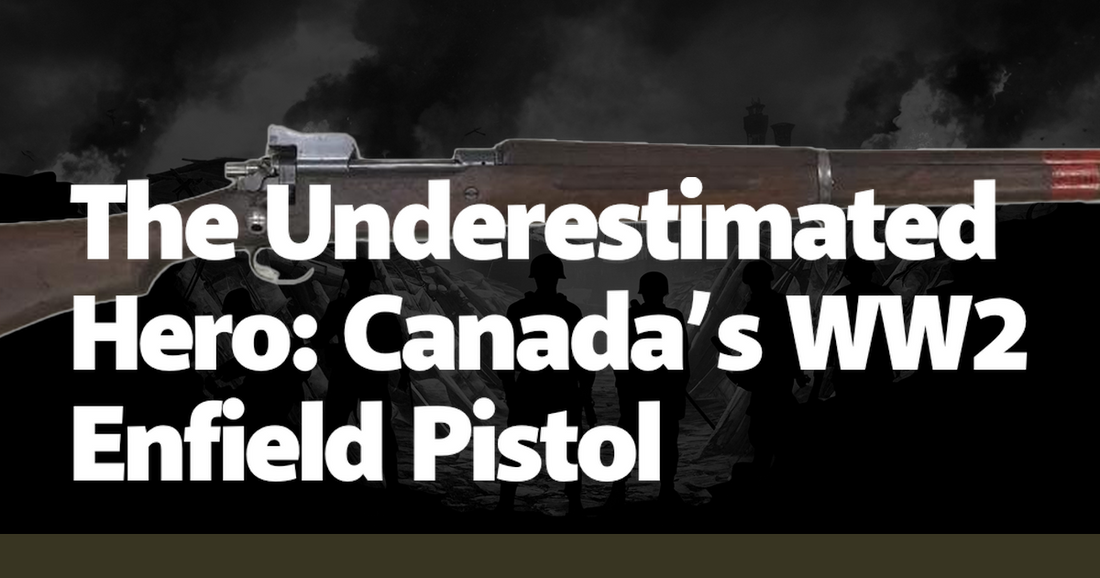The Enfield No. 2 Mk I revolver, often overshadowed by its more glamorous counterparts, played an indispensable role in the hands of Canadian forces during World War II. This seemingly unremarkable firearm, chambered in .38/200, was a workhorse that saw extensive use across various theaters of war. Despite its modest appearance and the overshadowing presence of the American Colt and Smith & Wesson revolvers, the Enfield proved its mettle in the harshest conditions, earning the respect of those who wielded it. The Enfield's design, rooted in practicality and reliability, embodied the spirit of the soldiers who carried it into battle.
The Enfield revolver's journey began in the interwar period when the British Army sought to replace the aging Webley service revolvers. The Enfield No. 2 Mk I was adopted in 1932, and by the time World War II erupted, it was the standard-issue sidearm for British and Commonwealth forces, including Canada. The weapon was designed to be simple, robust, and easy to produce—qualities that were crucial as the war effort ramped up. Its double-action-only mechanism was a departure from the single-action revolvers of the past, allowing for quicker firing in the heat of battle. Canadian soldiers, whether in the frozen tundras of Europe or the sweltering jungles of the Pacific, found the Enfield to be a reliable companion.
One of the most compelling stories involving the Enfield revolver comes from the Dieppe Raid in 1942. Canadian forces, tasked with a daring assault on the French coast, faced overwhelming German defenses. Amidst the chaos, the Enfield revolver was a lifeline. Corporal Leo Major, later celebrated for his heroics, used his Enfield to great effect, engaging enemy forces in close-quarters combat. The revolver's reliability under such dire circumstances was a testament to its design. Despite the raid's overall failure, the Enfield's performance left an indelible mark on those who survived.
The Enfield's design was not without its critics. Some argued that the .38/200 cartridge lacked stopping power compared to the .455 Webley it replaced. However, the Enfield's proponents pointed out that its lighter recoil allowed for quicker follow-up shots, a crucial advantage in combat. Canadian soldiers appreciated the revolver's ease of use and maintenance, especially in the field where conditions could be unforgiving. The Enfield's rugged construction meant it could withstand the rigors of war, from the mud-soaked trenches of Italy to the dense forests of the Netherlands.
In the hands of Canadian soldiers, the Enfield revolver became more than just a sidearm; it was a symbol of resilience. Stories from veterans often highlight the personal connection they had with their Enfields. One such account comes from Sergeant Harold A. Marshall, who recounted how his Enfield saved his life during a night patrol in Normandy. Ambushed by a German squad, Marshall's quick reflexes and the revolver's dependable performance allowed him to fend off the attackers and regroup with his unit. Such anecdotes underscore the Enfield's role not just as a weapon, but as a trusted companion in the most harrowing moments.
The Enfield's impact extended beyond individual acts of bravery. It played a crucial role in the broader strategy of the Canadian forces. In the Italian Campaign, for example, the Enfield was instrumental in urban combat situations where its compact size and rapid-fire capability were invaluable. Soldiers clearing buildings and engaging in street-to-street fighting relied on the Enfield's quick draw and reliable action. The revolver's design, which facilitated easy reloading even under duress, proved to be a significant advantage in these high-stakes environments.
As the war progressed, the Enfield revolver continued to serve Canadian forces with distinction. Its role in training new recruits cannot be overstated. The revolver's simplicity made it an ideal training tool, allowing soldiers to quickly grasp the fundamentals of marksmanship and firearm maintenance. This ease of use translated to better-prepared troops on the front lines. The Enfield's presence in training camps across Canada ensured that every soldier, regardless of their eventual role, was proficient with a reliable sidearm.
In the annals of military history, the Enfield No. 2 Mk I revolver may not enjoy the same fame as the M1 Garand or the Thompson submachine gun, but its contributions to the Canadian war effort are undeniable. It was a weapon that, through its reliability and design, exemplified the qualities needed in the darkest days of World War II. For the Canadian soldiers who carried it, the Enfield was more than just a tool of war; it was a trusted ally, a symbol of their resilience and determination. The legacy of the Enfield revolver, though often underestimated, is a testament to the unsung heroes of the battlefield.

